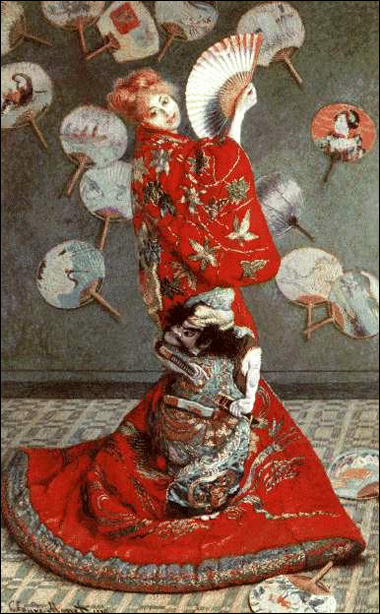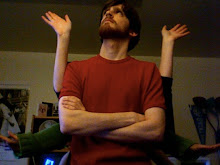In case anyone is interested, I've finally caved in and gotten a Tumblr to share all the awesome pictures I've saved over the years. Enjoy it!
http://classyshenanigans.tumblr.com/
...Also, this will prevent me from being tempted to make posts on this blog containing a single image.
Friday, May 28, 2010
Tuesday, May 25, 2010
100 Words #1
The other day, I felt inspired to do a little writing exercise: the hundred-word story. I recall doing stuff like this in high school and really enjoying it. I think I'm pretty good at setting a scene, if I say so myself, so this kind of thing suits me well!
Before the tramp could see the train, he could hear it coming. Not the rumble of the engine or the click-clack of the wheels, but the vibrations traveling through the rails. The steel hummed and twanged like something alive, reaching frequencies that made his teeth hurt. It reminded him of his youth on the farm, watching rabbits and voles fleeing the thresher that was chewing up their field. He stretched and picked up his pack. The train came, the pitch of its horn bending in his ears as it approached - and passed.
"Oh," he said sadly, "not stopping today."
* * *
Before the tramp could see the train, he could hear it coming. Not the rumble of the engine or the click-clack of the wheels, but the vibrations traveling through the rails. The steel hummed and twanged like something alive, reaching frequencies that made his teeth hurt. It reminded him of his youth on the farm, watching rabbits and voles fleeing the thresher that was chewing up their field. He stretched and picked up his pack. The train came, the pitch of its horn bending in his ears as it approached - and passed.
"Oh," he said sadly, "not stopping today."
Thursday, May 20, 2010
Video Games as Art
Donkey Kong, 1981
I recently read an article by the esteemed Roger Ebert entitled "Video Games Can Never Be Art." Ebert's core declaration is this: "No one in or out of the [gaming industry] has ever been able to cite a game worthy of comparison with the great poets, filmmakers, novelists and poets." Regardless of what you may think of video games, I think it can be agreed that this is a distressingly strong assertion. All art is, after all, subjective, even within the fields Ebert mentions. Generational differences play a large part as well - I imagine that Dickens might have a hard time accepting the novels of Cormac McCarthy (an author that Ebert specifically praises in the article) as "art". Then again, Dickens might not even think of his own writing as art; only relatively recently have we been so keen to draw a line between what is and isn't art across all media. My point is that Ebert is positioning himself as a voice of authority on what can be considered art - an egregious error as it is - and views video games with a fairly narrow mindset.
More after the jump!
Saturday, May 15, 2010
Ownership & Appropriation, Part V: Conclusion
As I hope these examples have shown, appropriation in art cannot be labeled as either wholly ethical or wholly unethical. After all, appropriation of one sort or another has led to revolutionary and changes in the Western conception of art in several ways, so it is irresponsible to ignore its cultural importance. There are, of course, unethical ways of appropriating art. Direct plagiarism – passing off another person’s creation as your own – is generally agreed to be reprehensible. There are also instances of one culture disrespectfully using another’s art for their own profit, such as Picasso’s refusal to acknowledge his African influences. Even appropriation within a single culture can be a dishonor to the original source, such as the totem pole imagery used in some Native American casinos. This does not change the fact that appropriation can be done respectfully and without infringing on the rights or traditions of others. Intent is a crucial element in determining the morality of appropriation. When people like Warhol and Prince alter an existing photo, they make no effort to pass off the photo as their own - they simply want to use it as raw material for sending a message. The Impressionists were not trying to replace Japanese art with their own, but instead to expand their artistic vision. In The Secret of Kells, Tomm Moore takes much from the Book of Kells and rewrites its history, but does so out of respect for the book’s importance to art and his cultural heritage. If I take a photograph of graffiti in an alley, I am in no way trying to tell people that I can create interesting art with a spray can; I am merely showing them what interests me in the juxtaposition of beauty and grittiness in the urban environment. In most of the examples analyzed in this paper, my judgment is that the appropriators were not trying to steal another’s art, or to become rich and successful without doing any work. They saw someone else’s art and believed that they could do something new, inspired, important, and unique with it. The poet Audre Lord once said “There are no new ideas. There are only new ways of making them felt.” The quote may be somewhat cynical, but I believe it lends credence to the idea that appropriation can be an acceptable way of expanding one’s artistic sphere. Much of the artistic appropriation seen in recent history can be attributed to this idea. So, if an artist takes his cues from an existing piece of art, or the art of another culture, or that of his own culture, we as viewers should consider his treatment of that original before condemning him.
* * *
...And that's my senior project! The essay part of it, at least. Looking back on it, even just a few weeks later, I can see things I want to change - like the implication that the Seven Cedars Casino and The Secret of Kells are indicative of the entire Native American and Irish cultures' take on appropriation. But...ah well, I wanted to post it in its natural state. Hope you enjoyed it!
Bibliography after the jump, if you're at all curious!
Thursday, May 13, 2010
Tuesday, May 11, 2010
Sunday, May 9, 2010
Ownership & Appropriation, Part II: Appropriation of Specific Works
Click the jump for the second part of my essay examining appropriation!


Warhol - "Marilyn Monroe"
Ownership & Appropriation, Part I
I am going to break my RC Arts & Ideas senior project essay into chunks and upload each section as its own blog post. This is the beginning. Enjoy!
* * *
Art is everywhere, and you need not visit a museum to encounter it. The billboards along the highway, the shows we watch on television, the graffiti in the alleyway; it is impossible to live a day in a modern life without experiencing someone’s creative output in some way or another. Whether this art entertains us. annoys us, or simply slips under our radar, it affects our lives deeply. Our society, personal tastes, and culture are shaped by it. It may be this ubiquitous influence of art upon us that leads to questions of ownership, appropriation, and creativity. Who owns an idea or an image? How do we define originality? Is it thievery to learn and incorporate the techniques of others? In my opinion, appropriation can be performed in a manner that is ethical and legitimate. If an appropriator pays respect to the original artist, or if the end product sufficiently changes the art’s meaning, appropriation can be acceptable. In this essay, I will examine several types of artistic appropriation, each highlighting a different element of the debate of originality and legal and cultural ownership.
Friday, May 7, 2010
I Can't Believe It's Not A Blog!
Wow!
Wait, wait...it is a blog. I guess that's why I was so convinced!
Wait, wait...it is a blog. I guess that's why I was so convinced!
Subscribe to:
Posts (Atom)




